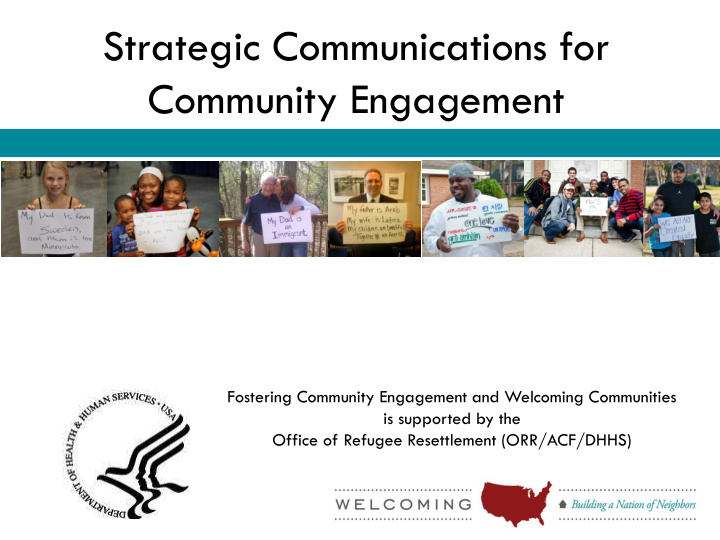



Strategic Communications for Community Engagement Fostering Community Engagement and Welcoming Communities is supported by the Office of Refugee Resettlement (ORR/ACF/DHHS)
Outcomes for Today‘s Webinar Develop a basic understanding of strategic communications and its importance Identify key audiences Explore messages that resonate Review some basic tactics Begin to apply these methods in your own context
Agenda Overview of Strategic Communications Strategies in Action: Dan Trudeau , Episcopal Migration Ministries Lillie Wolff , Welcoming Michigan, Michigan Immigrant Rights Center Michelle DePlante , Welcoming Rhode Island, Dorcas International Institute Rhode Island Putting it All Together: the GAME Plan Next Steps for Learning
A World on the Move: International Migrants 250 214 million people 200 2.9% 150 100 77 million people 50 2.5% 1960 2010 Source: International Organization for Migration
Refugees and Prosperity Messages Competing in a twenty-first century economy will require taking full advantage of our most important resource — our people. And that means welcoming the new Americans who are starting businesses, committing to our community, and helping build a stronger local economy. When you look at refugees in our community, you see people who share our values — people working hard to provide for their families and build a stronger economy for all of us.
Why Strategic Communications? An essential tool in fostering a more positive community climate for refugees A means to an end: helps to engage people that will help you reach your goals. Clarifies who we need to reach, how to speak to them, and through what channels.
Outcomes Build more support for your work and more goodwill for the refugees in your community Provide an alternative to divisive rhetoric by communicating about refugees in ways that promote unity. Assume a proactive approach by reframing the conversation.
Who is the Receiving Community? Long-time residents May be very diverse In some cases, can be foreign-born themselves May have conscious or unconscious fear or bias toward newcomers, or are simply ambivalent Those who don‘t live and breathe this work. Our neighbors and loved ones.
The Unsure and the Untapped Unsure The ambivalent middle 60% Untapped Sympathetic - would engage if asked Tapped
Understanding the Unsure May be coping with process of change and adaption Can feel a sense of loss – that their culture or resources are being taken away May not have frequent contact with refugees and immigrants May be exposed to misinformation about refugees Respond on basis of values and emotions that we can tap into
Principles for Communicating Start with positive messages they relate to and that speak to their beliefs and shared, local values Communicate through spokespeople with greatest credibility ‗ Focus on how RC members benefit, vs. how they are obligated Localized, accurate, informative - Photo credit: Hillary Andrews avoid restating myths Important to involve refugees
Speaking to the Unsure in Tennessee
Visual Campaign Images Nebraska is Home Welcoming Colorado
North Carolina Billboard Campaign
Why We Care
Episcopal Migration Ministries EMM Video: Refugee Community Allies - vimeo.com/39648553
Welcoming Michigan
Welcoming Rhode Island Stories ―You hear about all this, but when you meet someone in person … it definitely changed my perspective on immigration and people in general‖
The GAME Plan Engagement Message Audience Goals
Goals What outcomes do you want to see as a result of your efforts? Goals should be specific, realistic, and measurable
Audience Examples: decision makers, influentials, constituents, donors Who needs to hear your message? Who must be moved to action? Who has the power to help? Be specific “ The public ” is not an audience Know your audience What do they care about? What are their obstacles to engagement? Who do they trust?
Message What values do my audience and I share? What will you say to your audience to convince them to act as you wish them to?
Values - Opportunity
Values - Respect
Values - Faith
Community Our communities are strongest when everyone who lives in them feels welcome.
Opportunity and Prosperity Without the energy and intellect and innovation of our immigrant community, Montgomery County would, quite simply, be incomplete. ―New Americans‖ are a critical piece in building a better future for all County residents. - County Executive Ike Leggett Montgomery County, Maryland
Empowerment - CARE Examples
Engagement How will you get your messages to your audience? What tactics will be most effective while using the least resources? Personal outreach Social media Paid media Earned media
Homework GAME Plan Worksheet What is your desired How do you know Who are your target Who influences them? result(s)? when you ’ ve audiences? reached it - how can it be measured? What values do my audiences and I share? How will we get the word out? THE MESSAGE: Earned Media: Which value(s) are at stake – why should your Paid Media: audience care? Social Media: Describe the problem. What is the solution? Other: What concrete action can your audience take?
Tools to Help Welcoming America‘s Strategic Communications Toolkit
Related Resources Welcoming America www.welcomingamerica.org/resources/refugees SPIN Project www.spinproject.org Smart Chart www.smartchart.org Opportunity Agenda opportunityagenda.org/immigrants_and_opportunity
Announcing the Communications Learning Circle Who: People interested in communicating about refugees What: An opportunity to connect with a peer network When: Quarterly Where: Conference calls Why: To develop greater communications expertise, capture the wisdom in the field and support each other‘s efforts
How to Join the Learning Circle Send us an email with the following: 1. The geographic reach of your work 2. Why you would like to join 3. Communication topics of most interest. hannah@welcomingamerica.org Deadline: May 1, 2013
Upcoming Webinar Learning from the Boise Model: A Comprehensive Planning Approach to Welcoming Thursday May 16 th at 1:00 EST To register visit: https://welcomingamerica.webex.com/welcomingame rica/onstage/g.php?t=a&d=663178166
What‘s next? Do your homework Apply to join the learning circle Send in your strong communications examples Share this webinar with others in your organization and network Let us know what other communications tools would be helpful
Contact www.welcomingamerica.org Susan Downs-Karkos Hannah Carswell susan@welcomingamerica.org hannah@welcomingamerica.org 303-808-1322 404-592-5621 Rachel Steinhardt rachel@welcomingamerica.org 404-592-5621
Recommend
More recommend